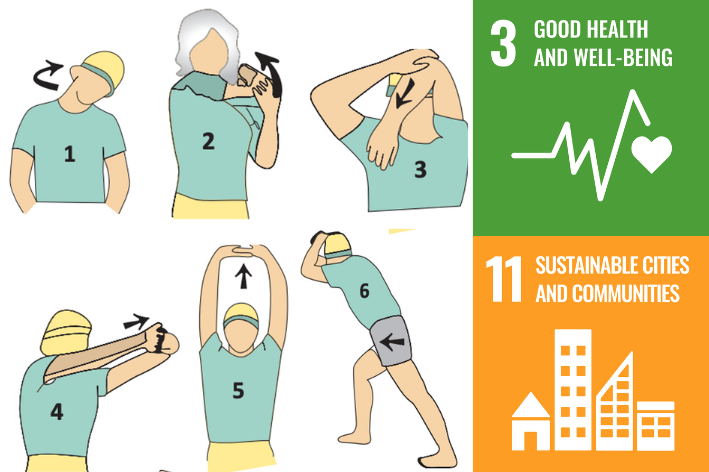Main Article Content
Abstract
Musculoskeletal discomfort is a common problem among adults, especially those living in mountainous areas. If left untreated, this condition can lead to long-term musculoskeletal diseases. This community service program aims to increase public awareness and understanding of the importance of preventing musculoskeletal disorders through the implementation of proper physical stretching exercises. The methods used in this program include community education on the physical activities needed to prevent muscle and joint problems, consultations, and stretching practices supported by community assistance. By involving health workers and community leaders, this program provides counseling and training on six types of static stretching. As a result, there was a significant increase in the community's understanding and ability to demonstrate effective stretching techniques. The community also showed active involvement in raising awareness about the importance of musculoskeletal health and successfully implementing strategies for the prevention of muscle and joint diseases. Through a holistic approach involving community leaders and local health workers, understanding of musculoskeletal disorders increased, leading to a positive impact on the quality of life for the community, especially in highland areas.
Keywords
Article Details

This work is licensed under a Creative Commons Attribution-NonCommercial 4.0 International License.
References
- Anggraini, N. V., & Hutahaean, S. (2022). Health education by ergonomic position coaching for back pain prevention in banana chips MSME’s workers. Community Empowerment, 7(9). https://doi.org/10.31603/ce.7166
- Behm, D. G., & Chaouachi, A. (2011). A review of the acute effects of static and dynamic stretching on performance. European Journal Applied Physiology, 111(11), 2633–2651. https://doi.org/10.1007/s00421-011-1879-2
- BPS Kabupaten Bangli. (2024). Kondisi iklim.
- Chen, H.-M., Wang, H.-H., Chen, C.-H., & Hu, H.-M. (2014). Effectiveness of a stretching exercise program on low back pain and exercise self-efficacy among nurses in Taiwan: A randomized clinical trial. Pain Management Nursing: Official Journal of the American Society of Pain Management Nurses, 15(1), 283–291. https://doi.org/10.1016/j.pmn.2012.10.003
- Health and Safety Executive. (2018). Work related musculoskeletal disorders in Great Britain (WRMSDs), 2018.
- Huang, R., Ning, J., Chuter, V. H., Taylor, J. B., Christophe, D., Meng, Z., & Jiang, L. (2020). Exercise alone and exercise combined with education both prevent episodes of low back pain and related absenteeism: Systematic review and network meta-analysis of randomised controlled trials (RCTs) aimed at preventing back pain. British Journal of Sports Medicine, 54(13), 766–770. https://doi.org/10.1136/bjsports-2018-100035
- Indrayani, N. L. D. (2020). From Job Analysis Approach to Identify Work-Related Musculoskeletal Discomforts (WRMDs) and its Physical Ergonomic Risks in Furniture Manufacturing Workers. National Cheng Kung University.
- Indrayani, N. L. D., Kao, C. Y., Suyasa, I., Padmalatha, K. M. S., Chang, J. H., & Wang, C. J. (2024). Effectiveness of exercise programs to reduce low back pain among nurses and nursing assistants: A systematic review and meta-analysis. Journal of Safety Research, 89, 312–321. https://doi.org/10.1016/j.jsr.2024.01.001
- Jin, Z., Wang, D., Zhang, H., Liang, J., Feng, X., Zhao, J., & Sun, L. (2020). Incidence trend of five common musculoskeletal disorders from 1990 to 2017 at the global, regional and national level: Results from the global burden of disease study 2017. Annals of the Rheumatic Diseases, 79(8), 1014–1022. https://doi.org/10.1136/annrheumdis-2020-217050
- Kementrian Kesehatan RI. (2016). Buku Kesehatan Lanjut Usia. Direktorat Jenderal Kesehatan Masyarakat Kementerian Kesehatan RI.
- Moreira, R. F., Moriguchi, C. S., Carnaz, L., Foltran, F. A., Silva, L. C., & Coury, H. J. (2021). Effects of a workplace exercise program on physical capacity and lower back symptoms in hospital nursing assistants: a randomized controlled trial. International Archives of Occupational and Environmental Health, 94, 275–284. https://doi.org/10.1007/s00420-020-01572-z
- Murray, C. J. L. (2020). Global burden of 369 diseases and injuries in 204 countries and territories, 1990–2019: A systematic analysis for the global burden of disease study 2019. The Lancet, 396(10258), 1204–1222. https://doi.org/10.1016/s0140-6736(20)30925-9
- Page, P. (2012). Current concept in muscle stretching for exercise and rehabilitation. The International Journal of Sports Physical Therapy, 7(1), 109–119.
- Ratzon, N. Z., Bar-Niv, N. A., & Froom, P. (2016). The effect of a structured personalized ergonomic intervention program for hospital nurses with reported musculoskeletal pain: An assigned randomized control trial. Work: A Journal of Prevention, Assessment & Rehabilitation, 54(2), 367–377. https://doi.org/10.3233/wor-162340
- Sastrawati, D. K., Partiwi, P. H., Ridwanti, L. P. P. W., Haris, A., Astawa, I. K., Susila, I. P. W. A., & Indrayani, N. L. D. (2025). Studi Literatur Pengaruh Aktivitas Fisik Terhadap Osteoarthritis Lutut Lansia. Ranah Research: Journal of Multidisciplinary Research and Development, 7(2), 14. https://doi.org/10.38035/rrj.v7i2.1350
- Shiri, R., Coggon, D., & Falah-Hassani, K. (2018). Exercise for the Prevention of Low Back Pain: Systematic Review and Meta-Analysis of Controlled Trials. American Journal of Epidemiology, 187(5), 1093–1101. https://doi.org/10.1093/aje/kwx337
- Taulaniemi, A., Kankaanpää, M., Tokola, K., Parkkari, J., & Suni, J. H. (2019). Neuromuscular exercise reduces low back pain intensity and improves physical functioning in nursing duties among female healthcare workers; secondary analysis of a randomised controlled trial. BMC Musculoskeletal Disorders, 20, 1–15. https://doi.org/10.1186/s12891-019-2678-x
- Thetkathuek, A., & Meepradit, P. (2018). Work-related musculoskeletal disorders among workers in an MDF furniture factory in eastern Thailand. International Journal of Occupational Safety and Ergonomics, 24(2), 207–217. https://doi.org/10.1080/10803548.2016.1257765
- Van-Hoof, W., O’Sullivan, K., O’Keeffe, M., Verschueren, S., O’Sullivan, P., & Dankaerts, W. (2018). The efficacy of interventions for low back pain in nurses: A systematic review. International Journal of Nursing Studies, 77, 222–231. https://doi.org/10.1016/j.ijnurstu.2017.10.015
- Watts, T., & Green, J. E. (2023). Collaborating With Community Partners to Address Population Health in an Online Advanced Nursing Practice Course. Nurse Educator, 48(6), 310–315. https://doi.org/10.1097/NNE.0000000000001414
- Woods, K., Bishop, P., & Jones, E. (2007). Warm-Up and Stretching in the Prevention of Muscular Injury. Sports Medicine, 12, 1089–1099. https://doi.org/10.2165/00007256-200737120-00006
- Yuniartika, W., Sudaryanto, A., Nofandrilla, N., Ananta, D. S., Alea, Z. N., & Hanifah, A. D. (2024). Low-impact aerobic exercise as a non-pharmacological intervention for reducing uric acid levels. Community Empowerment, 9(10), 1429–1436. https://doi.org/10.31603/ce.11627

